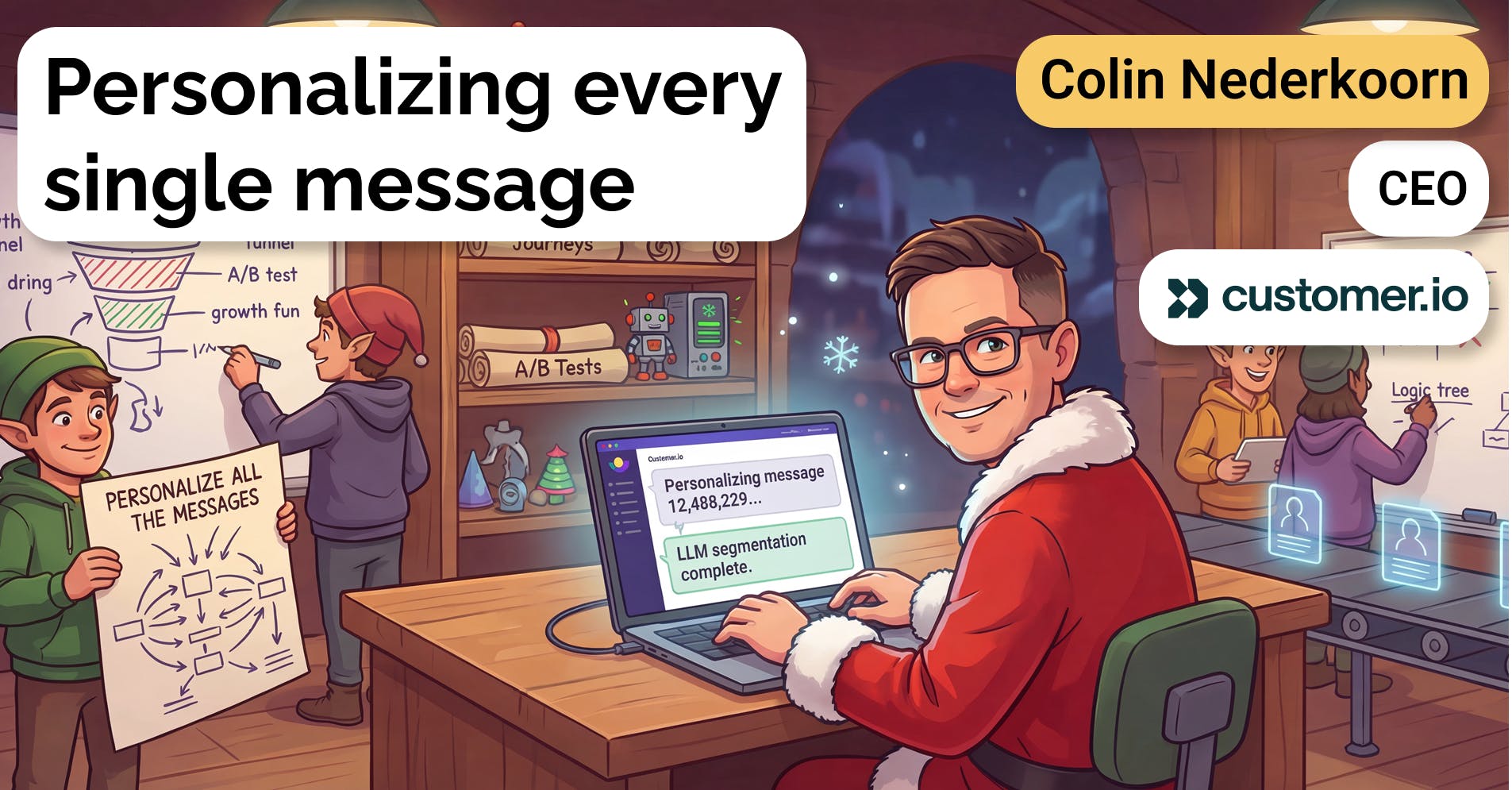Startup marketer on the process of choosing a customer communications platform
 Jan-Erik Asplund
Jan-Erik Asplund
Questions
- Could you start by telling me how you started using Customer.io and for what?
- I'd love to know more about how you see that flexibility in the day-to-day, compared to your experience using something like HubSpot or ActiveCampaign or MailChimp.
- How is your email usage distributed across these different types of messaging, between transactional, more marketing campaign-driven, and then more product and behavior-driven messaging?
- What's the benefit to doing these through the transactional API versus just this hack with campaigns?
- I'm curious to learn a little more about how that relationship between you and the engineering team works.
- How much would you say you’re able to do in the product without engineering help at this point?
- I’m curious given the sales tools you’re using if you’ve made any use of Customer.io itself as a CRM with the user profiles that are built in.
- Are there any other features that you would like to see in the product?
Interview
Could you start by telling me how you started using Customer.io and for what?
Guest: Yep. This is my third tech startup and my third job where I've been doing email marketing heavily.
So previous email service providers I've used were HubSpot, ActiveCampaign, ConstantContact, SendGrid, and MailChimp. So those were the ones I'd come from before when it was time to get an email service provider set up here. I had originally suggested MailChimp because I was familiar with it.
And so we actually went through and got MailChimp and did all of the setup and we were using MailChimp plus Mandrill for transactional. And then I was using Zapier to hook everything together. Went through, got everything set up. And then our CEO said no, and he yanked all of that and he implemented Customer.io.
So this was very much not my decision, which is not a bad thing. It's fine. Like it's a startup and I didn't expect to use the same system forever or for all that long. And I work with a bunch of devs and I've worked with a bunch of devs for a while now, and there's very much dev-centric systems. I would say SendGrid being the one I've used that I would put in that category, and I would now put Customer.io in that category, I think. Where I can't just go in there and get things set up and I need people to hook up systems on the back-end and pass through events.
Once that's done, I find that experience to be really great, but I definitely think there's the caveat of if you don't know anything about software development I don't know if Customer.io would be the best fit for people. Particularly if it's like a small business. If you run like a flower shop and you just want to send newsletters to your customers, I don't see it as being a good fit just because the flexibility makes it complicated for people who are just looking for something really straightforward.
We use Segment with Customer.io as both a source and destination to send data back and forth to and from other platforms. So for example, we use Mixpanel for analytics, and that was a really easy set up. So we can see like campaign data in Mixpanel to easily run reports on it.
We were working to get Salesforce set up with everything, which has been a pain in the ass, but that's Salesforce. But we are now able to get Customer.io transactional and marketing emails into Salesforce on the activity pane. So we have a complete view of both like cold outbound emails that are coming from Outreach, which we're using for that and Customer.io, which is nice.
But once again, that's something that like, As a marketer, I have no insight into how they did that. I just know that like we've been testing it and now it works and stuff was done on the backend that I'm not sure what magic transpired.
I'd love to know more about how you see that flexibility in the day-to-day, compared to your experience using something like HubSpot or ActiveCampaign or MailChimp.
Guest: Yep. Because we put everything into MailChimp first, it's super easy for me to tell you that. HubSpot I haven't used in a year or something, I think I've forgotten a lot of it. But so MailChimp, in order to segment users, I had to create workflows in Zapier that added tags when an event happened. So someone fills out a contact form. Zapier would have a step in the zap that would say, add contact to tag form, and that would then get moved into MailChimp. And then in MailChimp I could say, okay, everyone that has this tag gets this email. That was really a clunky way to do it. And I'm really glad that we ripped that all out and stopped doing it because with Customer.io, I know they can just pass through events straight through.
So now the second someone fills out a contact form on our marketing site or signs up for our web app, Customer.io knows that event from the backend. And it's really easy then for me to create campaigns from those events. And I also find that the segmentation in Customer.io is excellent. I love making the data-driven segments and how you can create like subgroups within them. That was something that I somehow stumbled across on the docs because I was looking to do, I don't remember how I found it, but I was really like lit up by that. That was a really cool feature. I don't think I've come across before just how easily it is to create those data-driven segments.
The campaign builder in Customer.io is like miles ahead in terms of the logic that you're able to do and the segmentation that you're able to do. I didn't find that was the case in MailChimp. And like I said, because all of the tags and the ways to segment it had to be done in Zapier, it was, I was a bit like, how is this going to scale?
If we can't easily. If we can't rely on like the events being passed through correctly, like that was a concern to me. So when our CEO was like, yeah, we're going to stop using this. I was like, great. That's good. It wasn't, I wasn't upset about it, even though it was like my idea to use it in the first place.
So in Customer.io I wanted to find people who had subscribed to our newsletter had not opened the last three newsletters. And had not opened any other email from us at all to find people who were like super, super unengaged in the last few months. And being able to use like the grouping logic on that was really cool. Cause the idea is that I want to send them an email that says "Hey, if you're not interested, we're going to take you off the list. If you're interested, click here and we'll keep you on" just as a last-ditch thing to try to get people engaged and if not clean them out. So I thought that was way better than any system I've used in the past in terms of like hyper segmenting people based on activity, both in customer and overall.
How is your email usage distributed across these different types of messaging, between transactional, more marketing campaign-driven, and then more product and behavior-driven messaging?
Guest: So when we, I think we signed up for it, it probably was in like October or November of 2020. I think the transactional API was still in beta. And so we have not. So we had originally set up all of our transactional emails as campaigns.
So we need to switch that. The biggest pain point for me as a marketer is I can't do that without dev help. So I like that's one of the pain points is like, The team where we just came, we just hired our 11th person. So we're still very small. We're still like, we just, our seed raise or super small.
And there's just not really a lot of engineering bandwidth right now for things like that. There's a story for it, but like when they get to it, so we've still been sending them as campaigns, which works fine. Like the deliverability is actually really good. But ideally what it would look like is we would have.
Sign up password reset confirmations, all that would go through the transactional API campaigns. The plan for that is to use those for onboarding campaigns for people who, when they sign up for a free version, especially we'll get marketing emails through a campaign to try to get them engaged.
And I've set up a couple drafts of those. And once again, with the logic, it's really cool because I can say, if they signed up. And then they've signed it again. We can send them one message, like great to see you're using the platform, but if they've signed up, I never came back. I haven't split out to send them an entirely different message and then to keep branching from there.
And again, I think that's way easier in this platform than other ones I've used. And then for the broadcasts or currently sending our newsletters and something else we want to do that once again is waiting on dev involvement. Is we want to send product like product updates to people who use the platform, but did not ever sign up to explicitly subscribe to our newsletter.
So that could and most of who that is people who were added as a user by their organization. John signs up. And then he invites three of his team members to our platform. So they're never even given a chance to opt into the newsletter or not. But we've heard feedback from our customers that when new features were rolled out, they'd know about them and they were a bit frustrated.
So obviously sending out a product, Hey, next week, this is going live in the platform. Obviously that would be great. The downside is we want to have the multiple custom unsubscribe types. And that means building a custom landing page on our site and passing those like options back through to customer IO.
So once again, that just takes them involvement, don't have time. And where MailChimp has for what they call it, that in my. MailChimp has just done something new preferences center. They're calling it a preferences center that easily generates like a unsubscribed link that then goes to a landing page that auto-populates the lists you've set up.
So they've made it really simple to no code one click enable. To manage that. And so once again, that's something like I'm stuck over here in marketing land and we're, we'll get to it. But I think some of that setup stuff
just has to be done by doubt. And sometimes it gets put on hold, especially in like smaller orgs and startups. But that's the overall plan is we're going to be using. Campaigns for like onboarding campaigns or like re-engagement campaigns broadcasts or newsletters or product updates and then transactional.
What's the benefit to doing these through the transactional API versus just this hack with campaigns?
Guest: I think I'm hoping deliverability. One thing is that we've gotten we've also because much as you're doing this with me now, our developer advocate, Taylor has been doing this with our customers.
The few things that feedback he got was that when someone with Gmail signed up, it went into their promotions folder, not the end of the world. It's not as bad as going to the spam folder. But I'm hoping with the transactional API, it might get better in Mox deliverability. Although I will say, I don't know enough technically to know how customer IO does it, but it does seem that this their deliverability, I think, is better than other platforms I've used in the past.
Even though in all of them, we ran them through our own domain and did all of that set up, but so I don't know if there's like a secret sauce that they have or whatever, but it does seem generally the deliverable deliverability is pretty good. But I think pulling that out and having it be more, a true transactional one might help with deliverability and then two, because we're not including any like canned spam footers on it, since it's not technically a marketing email, I'm hoping that could also help with any compliance issues in the future.
Just making sure that it's like a pure transactional message and that we won't run into any issues with that. Who we would run into an issue with that with three customers at this point. I don't know, thinking about scaling for that, but that's all correct. Yeah. Yeah. Sweet and so on. The dev is the the dev resources part of it.
I'm curious to learn a little more about how that relationship between you and the engineering team works.
Guest: Our CEO who chose this platform, he also chose outreach IO for Like sales, outbound emails. And I'm trying to think like your standard stuff, Zen desk, and ZoomInfo and Salesforce and all that. Like he, he set up a lot of this plumbing. It being on the CEO or shoulders is probably like the worst place for it to be because he's CEO.
So not a lot of time. That was, I think originally the idea of me using Zapier to wire it up, but I think just the general lack of flexibility. And I think the devs lack of insight into it, wanted to move them away from it. Basically the process right now is like right now he's doing a ton of work to get our whole customer data platform set up like this week, actually with like segment and Salesforce and all these things and making sure they all work.
And you, one thing we ran into is like in customer row, if they were to unsubscribe there, we need to make sure Salesforce and outreach. Have noted that the unsubscribed. So that was a thing where you know, bigger email service providers that have a native integration with Salesforce. I think it's I actually don't know if it's that much easier because MailChimp has, I was reading before this meeting to make sure it's accurate, like MailChimp, I think is the unsubscribed and mail Chimp still doesn't automatically check the email Salesforce.
I don't know if that's just like a Salesforce wide issue. But definitely something that we wanted to solve. And you, so you could say the plus side is that. Because customer, I was more flexible. The dumps have been now able to do that and to have that go into Salesforce or in a platform. I know we never got into MailChimp's API.
Like I know they have one, so I'm not sure how that would have worked there. But yeah, the dev team is technically I don't know, seven people and you could probably count our CEO in that. And he obviously has a million things to do with like that work. And most of what they're doing is still building out the product.
So things like marketing stuff have just been slow to get to, but that's fine because we haven't really, we just officially went to market at the end of March on March 30th was like our general availability launch. So new were like very early stage and even getting out there. And I think now's the time that we're picking a lot of this up.
How much would you say you’re able to do in the product without engineering help at this point?
I think probably one other thing to touch on is like the email builder and all of that. Being like a pretend like technical horse and I've used MJ ML in the past, which is like a lightweight like HTML email builders. And basically I have like super easy to learn. It's not commands, but like it's a super easy to learn structure that then translates your emails into HTML.
Like it exports it for you. And then you can put that into any email service provider you want. I've used that in the past was sent in grid to create emails in there. So I originally rebuilt all of our MailChimp campaigns in that and put it into customer IO. And then one thing that is really different is the concept of the content liquid and how.
The idea is to like, have a template. That's just the like header and footer, and then the liquid is the entire body. And then you put all of that customization in that was foreign to me because I'm more used to having like wood tags that are like, first name, last name, email company dollars spent, last login and having just like a predefined set of liquid to insert.
And I actually went back and forth with customer like customer service on this, just being a bit confused. I was like, why can't I add multiple. Content tags. And they're like, that's not how it works. I was like, I don't understand. That's how it works in every other platform I've ever used. In MailChimp, we had it all set up to to have the custom fields, like we want to have if their integration instance execution hits a limit, in AWS we have to send them an alert.
And so we're, I'm very used to being to do that. And so I think there's more of a blend of Transactional in with the marketing, that is a bit unique. And I can see that just, it's just a bit different to wrap your head around how that works. There's nothing wrong with it.
Once I figured out that you could just put. Like HTML styling, like in there, I was like, Oh I get how this works now. It's just, it's not the way I'm used to doing it. I also tried the drag and drop builder, which just totally fine. There's I can't really find any complaints with it. It's your standard like drag and drop builder?
It seems. Customer was really snappy. I find it's like the platform itself, like loads a lot faster and it's just really like nice and lightweight. But I ran into it once again, being in like that weird hybrid role, I ran into issues where when we updated our marketing site to the latest version of Gatsby, it starts converting all of our PNGs until webpage images.
So I can't rely on that CDN anymore. To like reference image links unless they put them in the SABIC folder, but that won't work for the blog images. Cause they're on the blog page. And so now I'm in that weird like middle ground of do I use the drag and drop told her and go like no code when I would rather have some flexibility and actually make each channel emails.
But now my CVN isn't really reliable anymore because it broke all the images and the old emails. And of course, like the devs don't think about that. Cause they don't think about these images of being in emails. And there's not really a big, like every other place I've worked. Like it, it's not like it's someone's fault.
It just seems to be like, because marketing and Dems don't always work super close together. There's always that like dependencies that get overlooked. And like they felt really bad. And I was like, this is not the first time that like. Images, anywhere else for me it's fine. So customer you have the flexibility of both, but now I'm like, maybe I should just do the drag and drop templates.
And then now I'm thinking of it more as a marketing platform and like less of a transactional dev platform. And then that makes me want certain features that marketing platforms have like the ability to build landing pages and the custom unsubscribe pages and I think and surveys was the other one surveys, like landing pages, like form builders, like those sort of things that are.
The marketers look for, like versus what devs look for, which I assume is like why they picked SendGrid in the first place. Cause when I first got here, we had SendGrid. And I was like, why do we have SendGrid?
Because I can't tell anything. There's no data there. Like they're their, data's three people opened your email and I'm like, what can I tell who it is? And they're like, no. And I'm like, why? This is useful. So I think. I don't know what, like the roadmap is for customer rail, but like my personal advice I think would be, there's a lot of really big marketing focused email service providers.
So I think it would make sense to lean in more to the dev side of it. And also working at a company now where we market to devs and we have a developer advocate on staff and I'm like learning more about the marketing and no one really loving SendGrid all that much. I feel like maybe there's a stronger market fit for them on that side.
But in order to compete with a MailChimp, like HubSpot active campaign, whoever there's just like a lot of features that aren't there at the moment. But I also don't know if it's worth even bothering, because I think that there is maybe like a dev first like email platform needed. And I think this could be a really cool fit for that market.
That's my I don't work there like 2 cents. Like I don't know what they're trying to do in the future. But I could, I can see that being really strong. Cause it seems like the people who work with customer O'Hare on the backend, like really like it and have nothing but good things to say about it.
I have very few bad things to say about it. I don't really like it. It's just that I get blocked frequently because I bought a dev.
I’m curious given the sales tools you’re using if you’ve made any use of Customer.io itself as a CRM with the user profiles that are built in.
I haven't only because we're pushing for Salesforce to be our single source of truth for everything. And that was a decision that like, I did not have input and which, again, that's fine.
But because we're doing more, we're going to do more account-based marketing and sales, and we are specifically targeting B to B. Software companies. So meaning software companies who work in vertical markets. So software companies who make software for like construction companies or software companies who make software for farmers or whatever.
I don't, we don't have any, anything close to a, B2C use case, or even just a traditional B2B use case where I think like a CRM would be day one, you would need to get that set up. This is really gonna live in. Like Salesforce and outreach. And most of our customers are going to be like multi-year contract enterprise customers, where once they're set up on the platform, like we're not going to need to do a lot of marketing to them.
Most of the marketing is going to be for people who sign up for our free version to see if we can either get them to convert, to paid, or really just having conversations with them about what they like. And don't like, because a lot of these people are devs who are trying out the platform, like because of its flexibility.
So we're more just interested in talking to them about what do you like, and not versus thinking that like a random Deb's gonna sign on for a multi-year and like enterprise deal. Like we don't see them as. Being the gateway into a company. That's probably going to be like the product people and the product marketing people.
So that's fine. So I think for us CRM and Customer.io, we'd be totally happy without it. Like it's not something that like we would necessarily need or want, but that's just because of our very like weird extra niche market we're going after. Yeah. Yeah. Cool. That makes sense.
Are there any other features that you would like to see in the product?
One thing that is somewhat annoying, unless if I'm just dominant, missing it is when it comes to the people tab. I find it difficult to like search by domain, for example. If I wanted to let's say like bulk delete people at most six to make a bunch of test accounts that we need to get rid of.
So There's a filter option, but I wrote down, but you can't say contains like in other platforms. So in other platforms that might be able to say like email address contains a domain and search for that. I don't know if you can do that in segments. Think you can do that in segments.
It's to create a segment, but I'm more just talking about like managing the people that are in there. So for example, all of our, like tests at prismatic accounts that we use and then have to get rid of, it would be cool to like, be able to filter and group people better, but not in the way you would want to do it for segments.
Cause it's not like we'd ever be sending to them. We would just want to like, and then I think some of the same kind of on a similar note with grouping people. To be able to group I don't think there's a way to say show me like the top 10 people that have been the most engaged, show me the top 10 users that have opened all of our emails and clicked on all of them.
So I can reach out. Maybe I want to give them a call for some reason. I don't know if there's a great way to get visibility into like groups of users activity and customer I'll. I don't think maybe there is. But I don't think so. Yeah. Yeah. Yeah. I'm not sure, but I think it speaks to, it speaks to the sort of a little bit of the CRM piece surfacing, like users more versus events.
Disclaimers
This transcript is for information purposes only and does not constitute advice of any type or trade recommendation and should not form the basis of any investment decision. Sacra accepts no liability for the transcript or for any errors, omissions or inaccuracies in respect of it. The views of the experts expressed in the transcript are those of the experts and they are not endorsed by, nor do they represent the opinion of Sacra. Sacra reserves all copyright, intellectual property rights in the transcript. Any modification, copying, displaying, distributing, transmitting, publishing, licensing, creating derivative works from, or selling any transcript is strictly prohibited.









